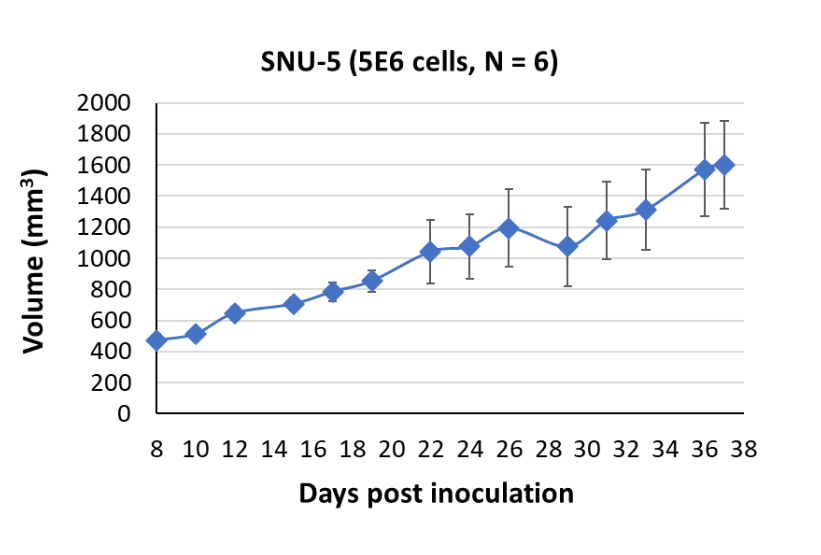About SNU-5
The SNU-5 cell line, derived from a primary tumor sample of a 57-year-old Korean male with gastric adenocarcinoma in 1986, serves as an important model for studying gastric carcinoma. These cells exhibit an adherent growth pattern and display epithelial morphology. A prominent feature of the SNU-5 cell line is the presence of a point mutation in the TP53 gene. TP53 is a tumor suppressor gene that plays a crucial role in regulating cell cycle progression and preventing the formation of cancerous cells. The mutation in TP53 observed in SNU-5 cells disrupts the normal function of this tumor suppression pathway, leading to uncontrolled cell proliferation and contributing to the development and progression of gastric carcinoma. Understanding the impact of TP53 mutation in SNU-5 cells provides valuable insights into the molecular mechanisms underlying gastric cancer and potential therapeutic targets.
Another noteworthy characteristic of SNU-5 cells is the overexpression of the ErbB2 protein, a member of the epidermal growth factor receptor (EGFR) family of receptor tyrosine kinases (RTK). Elevated levels of EGFR have been implicated in the pathogenesis of gastric carcinoma. The overexpression of ErbB2 in SNU-5 cells suggests the activation of downstream signaling pathways associated with cell growth, survival, and metastasis. This aberrant EGFR signaling contributes to the malignant properties of SNU-5 cells and highlights the significance of targeting the EGFR pathway in gastric carcinoma therapy.
Importantly, the SNU-5 cell line has demonstrated sensitivity to drugs targeting the MET receptor tyrosine kinase (RTK) pathway. MET is a receptor involved in cell growth, survival, and motility, and its dysregulation has been implicated in various cancers, including gastric carcinoma. Targeting the MET pathway with specific inhibitors disrupts the aberrant signaling and shows potential for therapeutic intervention in gastric carcinoma. SNU-5 cells’ sensitivity to MET-targeting drugs provides a valuable model to study the effects of inhibiting this pathway and evaluate potential treatment strategies for gastric cancer patients.
SNU-5 Tumor Kinetics in the SRG™ Rat

In animal models, xenografts of SNU-5 cells have been shown to form firm and well-defined tumors. These xenograft tumors represent a suitable platform for investigating tumor growth dynamics, evaluating therapeutic responses, and studying the interaction between tumor cells and the surrounding microenvironment. By studying SNU-5-derived tumors in vivo, researchers can gain insights into tumor biology, assess the efficacy of targeted therapies, and explore potential biomarkers associated with disease progression and response to treatment.
Products & Services
Xenograft Efficacy Studies
Includes collection of blood, tissues & tumor for ADME, PK/PD and analysis.
(Bi)weekly Tumor Sampling
Via fine needle aspiration (FNA). For longitudinal evaluation of drug exposure, histology and gene expression.
OncoRats
Cutting edge models optimized for engraftment.
Get help with your research by scheduling a call with Hera.
References (MLA):
- Fong, Jason T., et al. “Alternative Signaling Pathways as Potential Therapeutic Targets for Overcoming EGFR and C-MET Inhibitor Resistance in Non-Small Cell Lung Cancer.” PLOS ONE, Nov. 2013, journals.plos.org/plosone/article?id=10.1371%2Fjournal.pone.0078398.
- Leroy, Bernard, et al. “Analysis of TP53 Mutation Status in Human Cancer Cell Lines: A Reassessment.” Wiley Online Library, Apr. 2014, onlinelibrary.wiley.com/doi/10.1002/humu.22556.
- Organ, Shawna Leslie, and Ming-Sound Tsao. “An Overview of the C-Met Signaling Pathway .” Sage Journals, Nov. 2011, journals.sagepub.com/doi/10.1177/1758834011422556.
- Strickler, John, et al. “Diagnosis and Treatment of ERBB2-Positive Metastatic Colorectal Cancer.” Jama Network, Mar. 2022, jamanetwork.com/journals/jamaoncology/article-abstract/2789766.
